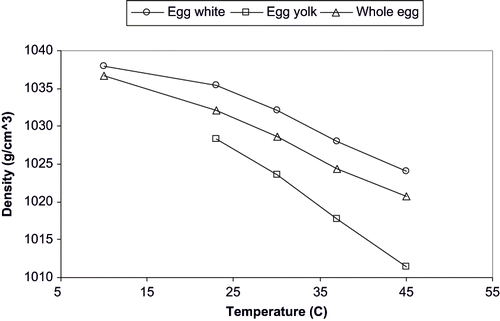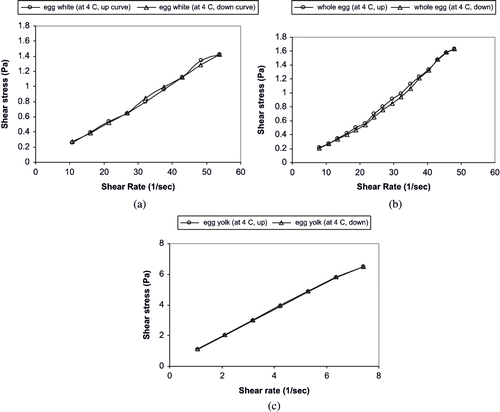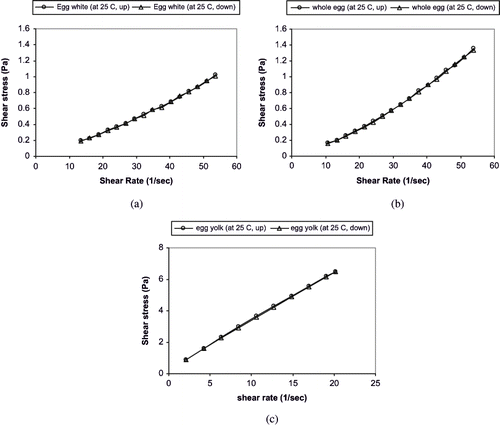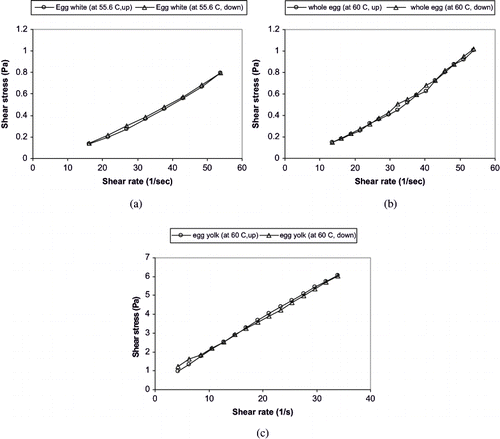Abstract
Rheological properties were determined at 4°C (refrigerated temperature), 25°C (room temperature), 60°C (pasteurization temperature) for liquid whole egg (LWE) and liquid egg yolk (LEY) and 4, 25, 55.6°C for liquid egg white (LEW) by using concentric cylinder viscometer. The shear rate range was 8 to 53.7 s−1 for LEW and LWE, and 1 to 34 s−1 for LEY. Selected physical properties (e.g., density) of LEPs were studied at broad range of temperatures from 4°C to 60°C. All liquid egg products (LEPs) exhibited mildly shear thinning (pseudoplastic) behavior. Experimental data of LWE and LEW successfully fitted Herschel-Bulkley model, LEY data were well described by power law model. LEW and LWE showed thixotropy and time-dependency at their pasteurization temperatures (55.6°C for LEW, 60°C for LWE) and considered being time-independent below these temperatures. LEY exhibited time-dependent behavior at 4°C and 60°C. But its rheological behavior showed no thixotropy and time-dependency at room temperature. The density of all three products decreased with increasing temperature. Density data were correlated by polynomial models (r2 > 0.99).
INTRODUCTION
Eggs are known as a perfect food for humans due to their high protein content, low cost and being readily availability in most of the countries. Egg posses both nutritional and functional properties and therefore used in many food products.[Citation1] For instance, egg albumen is known as suitable for confectionery and bakery industry with good whipping ability and good foam stability. Thus it is useful in binding and coagulative applications where albumen is essential. Egg yolk is the yellow part that forms approximately one third of the egg (33% by volume) and includes three fourths of the calories, most of the minerals and vitamins and all the fat content. Egg yolk is used for mayonnaise, dressings, sauces, pasta and other products.[Citation2,Citation3] Whole egg can be produced by mixing both liquid egg yolk and egg white. It is used as a main ingredient in bakeries, catering and the food industry. It is an additive in pies, pasta, biscuits or egg dishes such as scrambled eggs or omelets.[Citation3]
Because of the changing life style and technology, there is an increasing demand on the processed egg products. The term “egg products” refers to eggs that are removed from their shells for processing and convenience forms of eggs for commercial, foodservice, and home use. These products can be classified as refrigerated liquid, frozen, and dried products. Traditionally, eggs are marketed as shell eggs, but in recent years, egg consumption in the form of egg products has increased. Approximately 30% of all eggs sold in the USA in 2001 were processed.[Citation4] These products must be processed in sanitary facilities under continuous inspection and pasteurized before distributed for consumption.
USDA requires liquid egg pasteurization (conventional processing) to be conducted on a critical temperature–time condition where egg protein coagulation may not occur. Minimum temperature and holding time requirements for the egg yolk is 60°C and 6.2 min. For the egg white and whole egg, minimum temperature and holding time requirements are 55.6°C and 6.2 min., 60°C and 3.5 min, respectively.[Citation5] Although thermal pasteurization still represents the most available and best understood technique, it may affect the coagulation, foaming and emulsifying properties of egg products. Several pasteurization methods are explored to extend the shelf life of liquid egg products (LEPs) including ultrasonic wave treatment,[Citation6] high electric field pulses,[Citation7,Citation8] high hydrostatic pressure[Citation9] or ultrapasteurization combined with aseptic packaging.[Citation10] Most of these methods are thermal methods and cause substantial changes in the structure of liquid egg products. Particularly, coagulation and denaturation of proteins were the main problem.[Citation1] In response to these limitations, UV radiation can be an alternative non-thermal method of achieving appropriate reductions in pathogenic populations to extend the refrigerated shelf life of these products. But, the key factors for the success of continuous UV radiation treatment of LEPs include proper design of a UV chamber. The design should be done according to rheological and absorptive properties of the liquid material.[Citation11] Therefore, physical properties including rheological properties and density of food products are essential in designing of this process.
Although several researchers[Citation12,Citation13,Citation14,Citation15,Citation16,Citation17,Citation18,Citation19] investigated the rheological properties of liquid egg products, there are different conclusions reported about the rheological behavior of LEPs. The results of these studies showed Newtonian, as well as time-dependent non-Newtonian flow behavior of egg. These works are summarized in . Most of these studies have been usually carried out with only egg yolk. There is a lack of information about the rheological behavior of liquid egg white and whole egg at different temperature range. UV disinfection can be applied to continuous flow of LEPs at refrigerated and/or room temperatures as long as aseptic conditions are supplied. It can be also combined with thermal treatment in order to reduce the effect of heat on the quality of the LEPs. Therefore, understanding the rheological and physical properties of liquid egg products (LEPs) over a wide range of temperature is of utmost importance for the application of UV disinfection process in the egg-products industry. Additionally, the shear rate ranges used in the studies cited in the literature do not totally cover the shear rate range of the typical UV processing (8–53.7 s−1) for all LEPs ().
Table 1 Summary for the rheological studies of liquid egg products
The objective of this work is to determine rheological properties of liquid whole egg (LWE) and liquid egg yolk (LEY) at 4°C (refrigerated temperature), 25°C (room temperature), 60°C (pasteurization temperature) and shear rate ranged from 8 to 53.7 s−1 by using concentric cylinder viscometer. Rheological properties of liquid egg white (LEW) are studied at 4, 25, and 55.6°C. The shear rate range used for LEY is 1 to 34 s−1. Different rheological flow models (Newtonian, Power law and Herschel-Bulkley) based on shear stress shear rate are also tested to fit the experimental data. Selected physical properties (e.g., density) of LEPs are determined at broad range of temperatures from 4°C to 60°C. Additionally, time and temperature sensitivity, pH, and total solid contents of these products are also investigated.
MATERIALS AND METHODS
Sample Preparation
Fresh shell eggs (Grade A, large size, and uniform age), no older than 3 days after laying were purchased from a local farm and were held over night under refrigeration. Egg shells were washed with deionized water and hand broken properly. In order to separate chaladza and other membranous impurities, egg yolk was filtered by colander. Egg albumen was double filtered through colander and gauze to eliminate foam formation. The rest of the foam in egg albumen was eliminated by centrifugation at 600 rpm for 1 minute by keeping the temperature at 4°C. Whole egg was prepared by mixing approximately 14 broken eggs in the same container. Then it was filtered in order to separate impurities (chaladza, membranes). 600 ml of samples for each liquid egg product were prepared and stored at 4°C before measurement.
Density and pH values of LEPs were measured by using densitometer (Kyoto Electronics DA, Japan) and pH meter (Metrohm, Switzerland) at different temperature gradient. Total dry solid content (by weight percent) of each product were also determined in terms of AOAC 925.30 method.[Citation20]
Rheological Measurements
Viscosity measurements were conducted for liquid egg products at different temperatures by using concentric cylinder viscometer (Brookfield DV II + Pro, Brookfield Engineering Lab. Inc., MA, USA) equipped with a cylindrical spindle (LV-1) (cylinder diameter 18.84 mm, length 115 mm, beaker diameter 86.30 mm and 600 ml of sample volume). Since egg yolk samples were more viscous than other samples, LV-2C type spindle (cylinder diameter 10.25 mm, length 115 mm) was used for this product. Rotational speeds of these spindles ranged between 5 (1.02 s−1) and 200 rpm (53.7 s−1). A thermostatic water bath (Numan SMI model, Kerman, Turkey) was used to control the temperature within the range of 4 – 60°C. Before each measurement, the samples of liquid egg products were allowed to equilibrate at the desired temperature and a pre-shear step was conducted in all cases for ten minutes at a shear rate of 26.7 s−1 (100 rpm). Liquid egg white (LEW) and whole egg (LWE) were low viscous and egg yolk (LEY) exhibited considerably high viscosity. Therefore, LEW and LWE samples were subjected to a programmed shear rate linearly increasing from 8 to 53.7 s−1 (30–200 rpm), followed by a steady shear at 53.7 s−1 for 10 minutes and finally a linearly decreasing shear rate from 53.7 s−1 to 8 s−1 (hysteresis loop). LEY samples were sheared in a similar way but shear rate was changed from 1 to 34 s−1(5–160 rpm). During the shear, torque was recorded every 60 sec as a function of rotational speeds by a software program (Rheocalc32, Brookfield Eng., MA, USA) attached with the instrument and connected to a personal computer. At each rotational speed, care was taken to ensure that the torque has attained its steady state value. Measured torque values at different agitation speeds were converted to shear stress–shear rate data by using proper conversion equations (Brookfield manual, 2004). Ranges of shear rate for LEPs were selected to simulate the typical processing conditions. Shear rates at the wall within a commercial UV system under typical processing conditions (data calculated according to reference 18) have been 8 to 30 s−1. Therefore, shear rate ranges were chosen to cover this range. The onset of turbulent flow[Citation21] was also evaluated to ensure that the flow remained laminar. Three replicates were made for each sample at a given temperature and new samples were used for each test. Silicone oil standards (Brookfield viscosity standards, Brookfield Eng., MA, USA) were used to calibrate the viscometer[22].
Time Dependency and Thixotropy
Analysis of thixotropic fluids involves plotting changes in viscosity as a function of time. The apparent viscosity of time dependent thixotropic solutions decreases with time during shearing due to changes in the structure of the material. In order to investigate the existence of thixotropy in liquid egg products, structure breakdown was characterized by measuring the hysteresis loop. Shear rate ramps of increasing and then decreasing rates of 8–53.7 s−1 and 1–34 s−1 were imposed to asses the thixotropy of LEW and LWE, and LEY, respectively. Liquid egg products were sheared at constant low shear rates (LEW and LWE sheared at 16.12s−1, LEY sheared at 8.48 s−1) for 420 s and changes of apparent viscosity with time was considered as time dependency.[Citation23]
Data Analysis
The shear stress and shear rate were determined from the torque measurements, rotational speed and geometry of the system and calculated automatically by using the software attached to the system. Different rheological flow models [Newtonian EquationEq. (1), Power law EquationEq. (2), and Herschel-Bulkley EquationEq. (3)] based on shear stress shear rate were tested.[Citation21] Fitted functions were obtained by using the least square fit method of Excel[Citation24]. The suitability of the fitted functions was evaluated by the coefficient of determination (r2) as well as the standard error of estimate Sest [EquationEq. (4)]:
In order to quantify the effect of temperature on the viscosity or consistency coefficient, an Arrhenius type equation [EquationEq. (5)] was applied:
RESULTS AND DISCUSSION
In the present study, the pH and total dry solid content (%weight) were determined before the rheological and density measurements in order to obtain the information about the quality attributes of liquid egg products. These data are listed in and . pH values of all the egg products were found to be decreased by increasing temperature. This was due to the nature of chemical composition and ionic movement in the liquid, which are all temperature dependent. pH decreases because the ionic mobility increases with rising temperature and decrease with the amount of solid content in a product.[Citation8] The observed standard deviation values of total solid content (% weight) were 0.307, 0.060, and 0.079 for liquid egg yolk (LEY), liquid egg white (LEW) and liquid whole egg (LWE), respectively.
Table 2 pH of liquid egg products (LEPs) at different temperatures
Table 3 Total dry solid content of liquid egg products (LEPs)
The density of all three products decreased with increasing temperature (). Density (ρ) data were correlated by polynomial models (). All fitted functions presented r2 values higher than 0.99 and Sest lower than 1.1845. The results were in good agreement with those reported by Punidadas and McKellar.[Citation17]
Table 4 Temperature dependency of density of different egg products
Rheological Behavior
Time-dependency
A change in the liquid egg products´ viscosity over time indicates time-dependent behavior; a decrease signifies thixotropy. This decrease is an important consideration in process design. As the sample is sheared during its passage through the process system, the linkages between particles or molecules in the food are broken (structure breakdown), resulting in reduction in the size of the structural units and offer lower resistance to flow.[Citation23]
Thixotropic behavior of LEPs was examined by measuring hysteresis loop at different temperatures (, , 4). It is evident from that none of the products exhibited thixotropy at 25°C. On the other hand, LEW and LWE samples showed evidence of hysteresis at pasteurization temperature and 4°C, and LEY samples exhibited small degree of hysteresis only at 60°C ( and ). In order to confirm these findings, apparent viscosity at regular time intervals was recorded and studied in more detailed (). In , apparent viscosity of LEW and LWE at pasteurization temperature showed an increasing trend over the time and the fluctuation in apparent viscosity of LWE was more pronounced than LEW indicating thixotropic behavior. This might be due to the fact that LWE which has a high protein content was especially affected at 60°C, indicating that the chemical structure was broken primarily because of a susceptibility to heat (coagulation of proteins). Apparent viscosity of LEW and LWE at 4°C was constant over the given time period demonstrating time-independent behavior. LEY sample at 60°C also had a constant apparent viscosity until 300 seconds but declined after that. On the other hand, LEY samples at 4°C ceased time dependency after 150 seconds and the apparent viscosity became nearly constant. This could be attributed to its higher protein content than other products.
Rheological parameters
Different rheological models (Newtonian, Herschel-Bulkley and Power law) have been tested to ascertain the correct flow behavior of liquid egg products. Rheological parameters of LEPs were reported in . The coefficient of determination (r2), for all cases, were higher than 0.99 and standard error of estimates (Sest) were lower than 0.16 which confirms that selected models were adequately suitable for describing the flow behavior of LEPs within the range studied.
Table 5 Flow parameters for LEPs at selected temperatures
Yield stress was observed in the cases of LWE and LEW () and shear stress and shear rate data fitted Herschel-Bulkley model (EquationEq. 3) well at 4, 25, and 55.6/60°C. The flow behavior index (n) of LWE and LEW obtained from this model showed values varying from 0.9290 to 0.9878 indicating that, in this range of temperature, the liquid whole egg and liquid egg white are slightly pseudoplastic in nature. The consistency index (K) of both products varied from 0.021 to 0.038 Pa.sn and decreased with increasing temperature. Because the magnitudes of n were higher than 0.9, one could assume that these products have Newtonian like behavior and can be considered as Newtonian fluids in engineering calculations.[Citation25] Therefore, Newtonian model [EquationEq. (1)] was also applied to shear stress shear rate data of LWE and LEW. Newtonian viscosity values were found to be in the range of 0.017 and 0.037 Pa.s and, in the same way as the consistency coefficient (K), decreased when increasing temperature. Those findings were in agreement with the results of Scalzo et al.,[Citation25] Hamid Samimi et al.,[Citation13] and Hamid-Samimi and Swartzel.[Citation14] They reported that whole egg behaves as a Newtonian fluid below 60°C and pseudoplastic at temperatures above 60°C. Tung et al.[Citation26] also observed that egg white is slightly pseudoplastic at its respective pasteurization temperature. But the shear rate ranges were not indicated in those studies.
Table 6 Yield stress values for LEW and LWE at selected temperatures
In , , and ., it was evident that the shear stress-shear rate relationship at all temperatures were non-linear for LEY. Experimental data of LEY were fitted to power law model at given temperatures from 4 to 60°C. The value of consistency coefficient (K) ranged from 0.28 to 1.013 Pa.sn and the flow behavior index (n) ranged between 0.87 and 0.93 indicating pseudoplastic behavior. The egg yolk exhibited non-Newtonian and shear-thinning (pseudoplastic) behavior, which could be attributed to its chemical structure. The lipids of the eggs are all contained in the yolk. Nearly all of the yolk lipids are present as lipoproteins, which are classified as high density, low density and very low density lipoproteins.[Citation27] These types of high molecular weight polymers increase the viscosity even at very low concentrations.[Citation28]
Effect of temperature
For each liquid egg product, the effect of temperature on the viscosity at different shear rates is illustrated in . It was observed that apparent viscosities of LEPs decrease with increasing temperature. An Arrhenius-type equation [EquationEq. (5)] was used to quantify the effect of temperature on the rheological behavior of these products. Linear form of EquationEq. (5) was fitted to experimental data to find the values of the flow activation energies for different products tested. shows the data obtained from this fits. It can be seen that egg yolk has high activation energy (Ea) value which means that this product is more sensitive to temperature than other samples. It needs to have a great care if typical thermal pasteurization process will be applied to this product.
Figure 6 Effect of temperature on the viscosity as a function of shear rate (s−1) for (a) egg white; (b) whole egg; and (c) egg yolk.
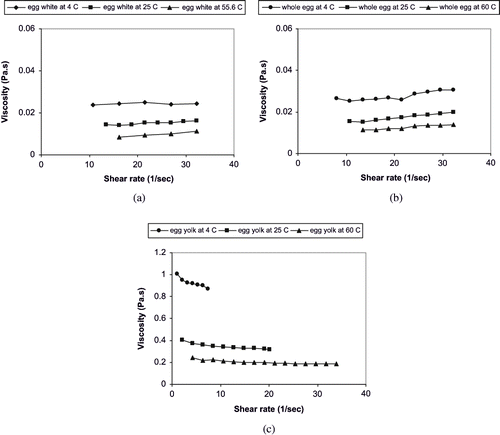
Table 7 Flow activation energies for liquid egg products (LEPs)
CONCLUSION
Rheological and selected physical properties of liquid egg products (LWE, LEW, and LEY) were studied as a function of temperature. Density data were well correlated by polynomial models and decreased by increasing temperature. Different rheological flow models (Newtonian, Power law, and Herschel-Bulkley) based on shear stress shear rate were applied to fit the experimental data. The good agreement between values predicted by these models and experimental values confirmed appropriateness of the equations proposed for describing the selected physical and rheological properties of liquid egg products (LEPs). Experimental data of LEW and LWE were successfully fitted to Herschel-Bulkley model, LEY data was well suited to power law model. It was found that liquid egg white (LEW), liquid whole egg (LWE), and liquid egg yolk (LEY) exhibited mildly shear thinning (pseudoplastic) behavior at 4, 25, and 55.6/60°C. LEW and LWE showed thixotropy and time-dependency at their pasteurization temperatures (55.6°C for LEW, 60°C for LWE). As a result, LEW and LWE were determined to be time-dependent at their pasteurization temperatures and time-independent below these temperatures. On the other hand, liquid egg yolk (LEY) exhibited time-dependent behavior at 4°C and 60°C. But, its rheological behavior showed no thixotropy and time-dependency at 25°C. An Arrhenius-type equation would be useful to quantify the effect of temperature on the rheological behavior of these products. The activation energy of LEY samples was found to be highest indicating higher sensitivity to temperature than other samples.
ACKNOWLEDGMENTS
This study was supported by Scientific and Technical Research Council of Turkey (TUBITAK), Project No: TOVAG-104 O 210 and the Department of Food Engineering, Izmir Institute of Technology, Izmir, Turkey.
Notes
Excel, Microsoft Corporation, WA, USA, 2002.
REFERENCES
- Ahmed , J. , Ramaswamy , H.S. , Alli , I. and Ngadi , M. 2003 . Effect of high pressure on rheological characteristics of liquid egg. . Lebensm.-Wiss.u.-Technology , 36 : 517 – 524 .
- Alvarez , E. , Cancela , M.A. and Macerias , R. 2006 . Comparison of rheological behaviour of salad sauces . International Journal of Food Properties , 9 : 907 – 915 .
- Stadelman , W.J. and Cotterill , O.J. 1995 . Egg science and technology , New York : The Haworth Press Inc .
- American Egg Board http://www.aeb.org (Accessed: 2006 ).
- USDA . 2003 . Pasteurization of liquid eggs . Code of federal regulations , 9 ( 2 ) 9CFR590.570.
- Wrigley , D. M. and Lorca , N.G. 1992 . Decrease of Salmonella typhimurium in skim milk and egg by heat and ultrasonic wave treatment . Journal of Food Protection , 55 : 678 – 680 .
- Ma , L. , Chang , F.J. , Barbosa-Canovas , G.V. and Swanson , B.G. 1997 . “ Inactivation of E. coli in liquid whole eggs using pulsed electric fields technology ” . In New frontiers in food engineering , Edited by: Barbosa-Canovas , G.V. New York : AIChE .
- Amiali , M. , Ngadi , M.O. , Raghavan , V.G.S. and Nguyen , D.H. 2006 . Electrical conductivities of liquid egg products and fruit juices exposed to high pulsed electrical fields . International Journal of Food Properties , 9 : 533 – 540 .
- Ponce , E. , Pla , R. , Mor-Mur , M. , Gervilla , R. and Guamis , B. 1998 . Inactivation of Listeria innocua inoculated in liquid whole egg by high hydrostatic pressure . Journal of Food Protection , 61 : 119 – 122 .
- Ball , H.R. Jr. , Hamid-Samimi , H.M. , Foegeding , P.M. and Swartzel , K.R. 1987 . Functionality and microbial stability of ultra pasteurized, aseptic packaged refrigerated whole egg . Journal of Food Science , 52 : 1212 – 1218 .
- Unluturk , S. , Arastoopour , H. and Koutchma , T. 2004 . Modeling of UV dose distribution in a thin-film UV reactor for processing of apple cider . Journal of Food Engineering , 65 : 125 – 136 .
- Kaufman , V.F. , Ijichi , K. and Putnam , G.W. 1968 . Flow characteristics in holding tubes of commercial egg pasteurizers . Journal of Milk Food Technology , 31 : 269 – 273 .
- Hamid-Samimi , M.H. , Swartzel , K.R. and Ball , H.R. 1984 . Flow behavior of liquid whole egg during thermal treatments . Journal of Food Science , 49 : 132 – 136 .
- Hamid-Samimi , M.H. and Swartzel , K.R. 1985 . Maximum change in physical and quality parameters of fluid foods during continuous flow heating. Application to liquid whole egg . Journal of Food Processing and Preservation , 8 : 225 – 239 .
- Ibarz , A. 1993 . Rheology of salted egg yolk . Journal of Texture Studies , 24 : 63 – 71 .
- Ibarz , A. and Sintes , J. 1989 . Rheology of egg yolk . Journal of Texture Studies , 20 : 161 – 167 .
- Punidadas , P. and McKellar , R.C. 1999 . Selected physical properties of liquid egg products at pasteurization temperatures . Journal of Food Processing and Preservation , 23 : 153 – 168 .
- Telis-Romero , J. , Thomaz , C.E.P. , Bernardi , M. , Telis , V.R.N. and Gabas , A.L. 2006 . Rheological properties and fluid dynamics of egg yolk . Journal of Food Engineering , 74 : 191 – 197 .
- Tung , M.A. , Watson , E.L. and Richards , J.F. 1970 . Rheology of fresh, aged and gamma-irradiated egg white . J. Food Science. , 35 ( 6 ) : 872 – 874 .
- AOAC . 1990 . Official methods of analysis , Washington, DC : AOAC .
- Rao , M.A. 1999 . Rheology of fluid and semisolid foods , Gaithersburg, MD : Aspen Publishers, Inc .
- Brookfield Engineering-Material Safety Data Sheets for Brookfield Viscosity Standards, paper 2479 http://www.brookfieldengineering.com/support/documentation/material-safety-data-sheets.asp (Accessed: September 2006 ).
- Figoni , P.I. and Shoemaker , C.F. 1981 . Characterization of structure breakdown of foods from their flow properties . Journal of Texture Studies , 12 : 287 – 305 .
- Excel, Microsoft Corporation, WA, USA, 2002.
- Scalzo , A. M. , Dickerson , R.W. Jr. , Peeler , J.T. and Read , R.B. Jr. 1970 . The viscosity of egg and egg products . Food Technology , 24 : 1301 – 1307 .
- Tung , M.A. , Watson , E.L. and Richards , J.F. 1971 . Rheology of egg albumen . : 17 – 19 . Trans. ASAE
- Lee , D. 2002 . “ Application of combined non-thermal treatments for the processing of liquid whole egg ” . In PhD Thesis , Berlin, , Germany : von der Fakultät III – Prozesswissenschaften der Technischen Universität .
- Damodaran , S. 1996 . “ Amino-acids, peptides and proteins ” . In Food chemistry , 3rd , Edited by: Fennema , O.R. New York : Marcel Dekker .
